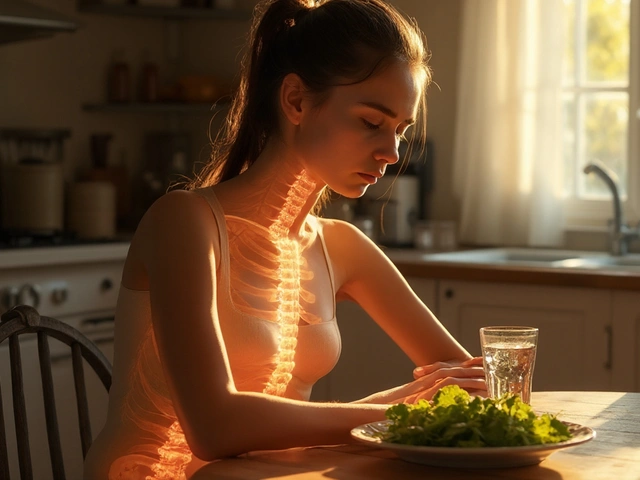Osteoporosis is a skeletal disease characterized by reduced bone mass and micro‑architectural deterioration, leading to increased fracture risk. When paired with Anorexia Nervosa, the condition becomes a silent threat that many clinicians miss until a break‑in‑bone occurs.
People with anorexia often focus on weight, not on the hidden erosion happening inside their bones. This article breaks down the biology, the warning signs, and what you can do to stop the cycle before a painful fracture shatters your life.
What Is Anorexia Nervosa?
Anorexia Nervosa is a severe eating disorder marked by self‑imposed calorie restriction, intense fear of gaining weight, and a distorted body image. The disorder typically emerges in adolescence, disproportionately affecting young women, though men are not immune. According to the National Institute of Mental Health, roughly 0.6% of the U.S. population meets criteria for anorexia at some point in their lives.
How Anorexia Undermines Bone Health
The link between anorexia and bone loss is multi‑factorial. Below are the core mechanisms that turn a thin frame into a fragile skeleton.
- Bone Mineral Density (BMD) drops dramatically. Studies show a 15‑30% reduction in BMD after just 12 months of severe caloric restriction.
- Estrogen levels plunge. Estrogen protects bone by inhibiting osteoclast activity; its deficiency accelerates bone resorption.
- Cortisol, the stress hormone, spikes during chronic under‑nutrition, further stimulating bone breakdown.
- Key nutrients-Calcium and Vitamin D-are often deficient, impairing the mineralization process.
Combine these factors, and the skeleton becomes a house of cards: each component weakens, making fractures a likely outcome even from low‑impact falls.
Diagnosing Bone Loss in Anorexia
Early detection hinges on reliable imaging and biochemical markers.
- Dual‑energy X‑ray absorptiometry (DXA) is the gold standard for measuring areal BMD at the lumbar spine, hip, and forearm. A T‑score ≤‑2.5 confirms osteoporosis.
- Quantitative computed tomography (QCT) offers 3‑D volumetric data, useful when DXA results are borderline.
- Serum markers-such as osteocalcin, procollagen type1N‑terminal propeptide (P1NP), and C‑telopeptide (CTX)-help track turnover rates.
Because hormonal suppression can mask classic signs, clinicians should screen any patient with a BMI<17kg/m² or a history of eating disorder for bone health, regardless of age.
Comparing Osteoporosis Risk: Anorexia Nervosa vs. General Population
| Factor | Anorexia Nervosa | General Population |
|---|---|---|
| Estrogen Levels | Often severely low | Within normal reproductive range |
| Calcium Intake | Typically < 800mg/day | ≈1000mg/day |
| Vitamin D Status | 25‑OHD often <20ng/mL | 30‑50ng/mL |
| Cortisol | Chronically elevated | Normal diurnal pattern |
| Physical Activity | Excessive, often endurance‑focused | Moderate, balanced |

Treatment Strategies Tailored to the Eating‑Disorder Context
Addressing bone loss in anorexia requires a dual approach: restore nutritional status and directly treat the skeletal deficit.
- Refeeding Protocols: Gradual caloric increase (≈1,200‑1,500kcal/day) to avoid refeeding syndrome, while monitoring electrolytes.
- Hormone Therapy: Low‑dose transdermal estrogen may improve BMD without triggering weight‑gain concerns. In some cases, oral contraceptives are insufficient because they don’t mimic physiologic estrogen patterns.
- Calcium & Vitamin D Supplementation: Aim for 1,200mg calcium and 1,000‑2,000IU vitaminD daily, adjusted based on serum levels.
- Bisphosphonates: Generally avoided in women of child‑bearing age; reserved for severe cases with documented fractures.
- Weight‑Bearing Exercise: Supervised resistance training 2‑3 times weekly can stimulate osteoblast activity without exacerbating the drive for thinness.
- Psychiatric Intervention: Cognitive‑behavioral therapy (CBT‑E) remains the cornerstone for lasting eating‑disorder remission, indirectly protecting bone.
Prevention: Building Strong Bones Before the Crisis Hits
Prevention starts long before a DXA scan. Here are actionable steps for patients, families, and clinicians.
- Screen teens with rapid weight loss for Bone Mineral Density risk using questionnaires and basic labs.
- Encourage a balanced diet rich in dairy, leafy greens, and fortified foods to meet calcium (>1,200mg) and vitaminD (>800IU) goals.
- Promote safe, weight‑bearing activities like stair climbing or light resistance bands rather than high‑intensity cardio.
- Monitor hormone levels (estradiol, LH/FSH) annually in patients with BMI<18kg/m².
- Provide education on the hidden danger of “thin = healthy” myths.
Related Conditions and Future Directions
Other eating disorders-bulimia nervosa, binge‑eating disorder-also affect bone, but the mechanisms differ. Bulimia’s frequent vomiting leads to metabolic alkalosis, which can impair calcium absorption, while binge‑eating often masks over‑nutrition that still fails to protect bone due to poor nutrient quality.
Emerging research looks at gut‑bone axis modulation, using probiotics to enhance calcium uptake, and novel anabolic agents such as romosozumab that may be safer for young women.
Putting It All Together: A Quick‑Reference Checklist
- Identify at‑risk patients: BMI<17, menstrual irregularities, prolonged dieting.
- Order DXA early; repeat every 12-24months if BMD <‑1.0T‑score.
- Correct calcium and vitaminD deficits; aim for serum 25‑OHD >30ng/mL.
- Consider low‑dose transdermal estrogen for pre‑menopausal women.
- Integrate CBT‑E alongside nutritional rehabilitation.

Frequently Asked Questions
Can men with anorexia develop osteoporosis?
Yes. Although estrogen‑driven bone loss is more prominent in women, men experience reduced testosterone, lower calcium intake, and elevated cortisol-all of which accelerate bone loss. DXA screening is advised for any male patient with a BMI<17kg/m² or a history of chronic dieting.
Is a normal weight guarantee that my bones are healthy?
No. Bone health depends on nutrient intake, hormone balance, and mechanical loading, not just body weight. People with normal BMI can still have low BMD if they follow restrictive diets, have endocrine disorders, or lead sedentary lifestyles.
How long does it take for bone density to improve after weight restoration?
Significant BMD gains usually appear after 12-18months of sustained weight gain (≥5% of body weight) combined with adequate calcium, vitaminD, and estrogen replacement when indicated. Early gains stem from reduced resorption; later improvements reflect new bone formation.
Should I avoid all high‑impact exercise while recovering from anorexia?
Controlled weight‑bearing activity is actually beneficial for bone. However, high‑impact sports that emphasize leanness (e.g., competitive gymnastics) should be limited until weight and hormonal status stabilize.
Is bisphosphonate therapy safe for young women with anorexia?
Bisphosphonates are generally reserved for severe cases with fractures because they linger in bone for years and could affect future pregnancies. Alternatives like teriparatide or estrogen therapy are preferred when possible.
What lab tests help evaluate bone health in anorexia?
Key labs include serum calcium, phosphate, 25‑OHvitaminD, PTH, estradiol (or testosterone in men), cortisol, and bone turnover markers (P1NP, CTX). Abnormal values can guide supplementation and hormonal therapy.



Spencer Riner
September 25, 2025 AT 06:48Wow, the way the article connects hormonal shifts with bone resorption is eye‑opening. I've seen DXA reports where a 10‑year‑old with anorexia already shows a T‑score below ‑2.5. It really underscores the need for early endocrine screening, especially estradiol levels. Also, weight‑bearing exercises can be a game‑changer if introduced safely.
Joe Murrey
October 3, 2025 AT 16:08definately gotta watch those calcium levels if ur diet is low.
Tracy Harris
October 12, 2025 AT 01:28It is a grievous oversight that the medical community often neglects skeletal assessments in the early stages of anorexia nervosa. The precipitous decline in estrogen precipitates an inexorable march toward fragility, a fate that could be averted with vigilant monitoring. Consequently, clinicians must integrate densitometry into routine evaluations without delay.
Sorcha Knight
October 20, 2025 AT 10:48Seriously, ignoring bone health while obsessing over the scale is a moral failing of our healthcare system 😤. We owe these young people more than a slap on the wrist; we owe them a fortress of bone.
Jackie Felipe
October 28, 2025 AT 19:08Bone loss is realy serious. It can happen fast in anorexia. Getting a DXA scan early can help.
debashis chakravarty
November 6, 2025 AT 04:28While the article correctly emphasizes estrogen deficiency, it neglects to mention that hypercortisolemia alone can precipitate osteopenia even in the absence of malnutrition. Moreover, the recommendation to "promote safe weight‑bearing activities" lacks specificity; high‑impact plyometrics are contraindicated until hormonal balance is restored. One must therefore adopt a more nuanced protocol rather than the blanket advice presented.
Daniel Brake
November 14, 2025 AT 13:48Reading this piece provokes a cascade of reflections on how we conceptualize the body as both a vessel and a battlefield. When an individual restricts caloric intake, the immediate physiological alarm is centered on energy deficit, yet the silent erosion of the skeletal matrix proceeds unnoticed. This dichotomy raises the question: why do we prioritize visible weight changes over the invisible march toward fragility? The endocrine system, particularly estrogen, serves as a sentinel for bone turnover, and its suppression creates a perfect storm for osteoclastic activity. Cortisol, often elevated in chronic stress, further skews the remodeling equilibrium toward resorption. One could argue that the psychosocial dimensions of anorexia-control, identity, and self‑worth-intersect with these hormonal cascades in ways that we have yet to fully decode. The literature suggests that early DXA screening can identify at‑risk patients before a fracture occurs, but practical constraints often delay such assessments. This delay is not merely a logistical oversight; it reflects a deeper cultural bias that discounts internal suffering unless it manifests externally. Moreover, the reliance on weight‑bearing exercise as a panacea overlooks the fact that without adequate nutrient repletion, mechanical loading may exacerbate micro‑damage. It is therefore imperative to adopt a multimodal approach that couples nutritional rehabilitation with endocrinological monitoring and judicious physical therapy. The interplay between calcium, vitamin D, and parathyroid hormone adds another layer of complexity, reinforcing the need for comprehensive lab panels. Philosophically, we must ask whether the medical model, which compartmentalizes mind and body, is sufficient to address a disorder that blurs those boundaries. In practice, interdisciplinary teams-psychologists, dietitians, endocrinologists, and orthopedic specialists-present the most robust defense against the hidden link described here. Ultimately, the goal is not merely to prevent fractures, but to restore a sense of wholeness to individuals whose bodies have been weaponized against themselves. By acknowledging the hidden link and intervening early, we honor the principle that preventive care is as vital as curative treatment.
Avinash Sinha
November 22, 2025 AT 23:08The silent thief that is osteoporosis sneaks in while the mind battles the scale, and the fallout is a kaleidoscope of broken dreams and shattered bones. Let's paint a brighter picture with proactive screening and vibrant nutrition.
ADAMA ZAMPOU
December 1, 2025 AT 08:28It is incumbent upon the clinical practitioner to recognize the ontological interdependence of somatic integrity and psychological resilience. The precipitous decline in mineral density, as elucidated herein, demands a preemptive diagnostic algorithm that integrates densitometric evaluation with endocrine profiling. Only through such a comprehensive schema can we hope to mitigate the inexorable progression toward skeletal fragility.
Liam McDonald
December 9, 2025 AT 17:48I hear you and it’s tough maybe we just need to keep an eye on bones early and support each other
Adam Khan
December 18, 2025 AT 03:08From a pathophysiological standpoint, the dysregulation of the hypothalamic‑pituitary‑gonadal axis precipitates a catabolic bone environment characterized by increased RANKL expression and suppressed OPG synthesis. Consequently, the risk stratification algorithm must incorporate biomarkers such as serum CTX and P1NP alongside BMD metrics to achieve precision medicine outcomes.